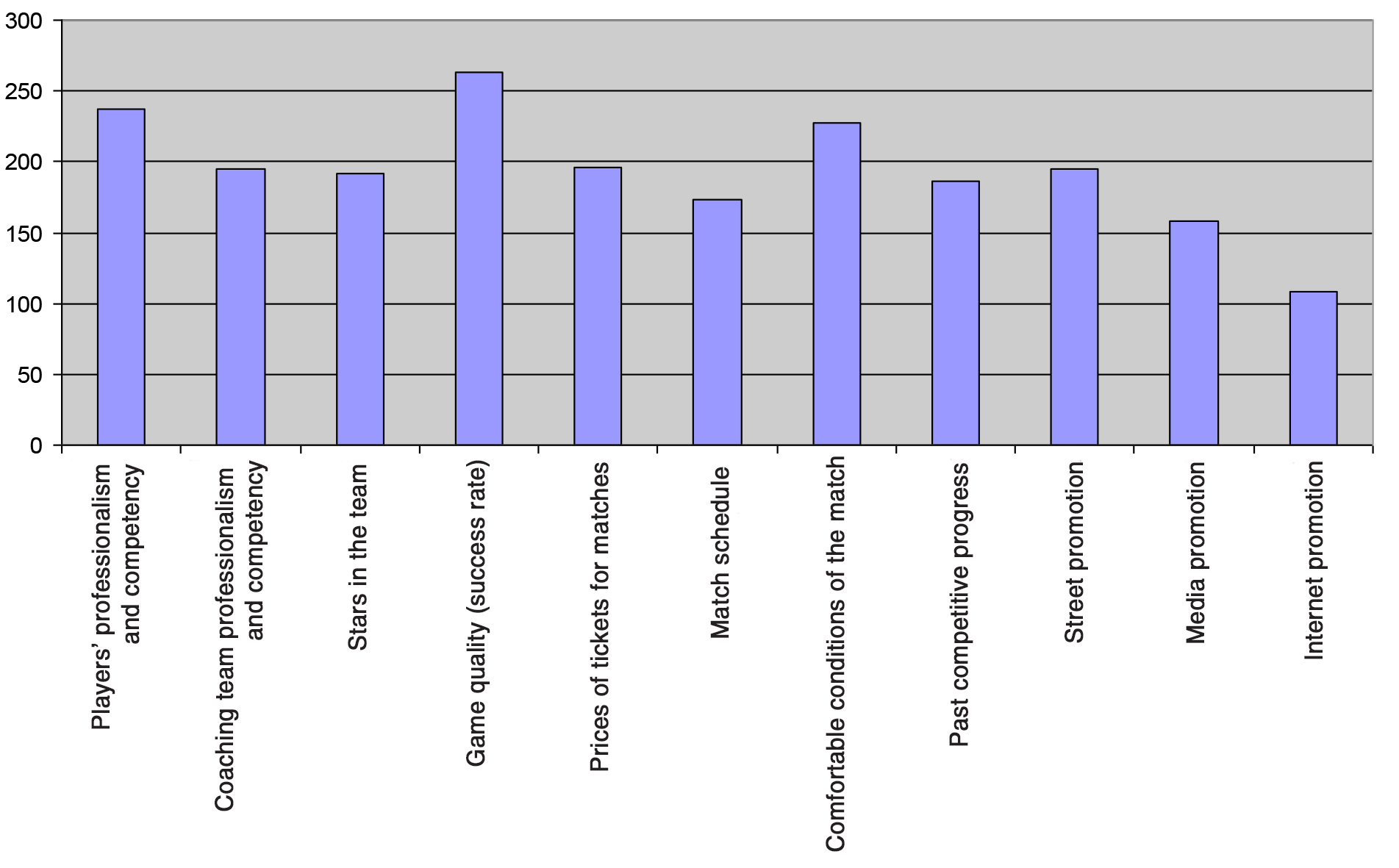Team image building based on sociological analysis of fan's attitudes
Фотографии:
ˑ:
Dr.Sc.Psych., Professor E.A. Petrova
PhD, Associate Professor M.A. Kovaleva
PhD, Associate Professor D.V. Semenov
PhD, Associate Professor V.A. Morozov
Russian State Social University, Moscow
Keywords: sport team image, would-be fans luring, sport promotion, analysis of associations.
Background. An image of an organisation is widely believed to be largely determined by attitudes of potential clients to its services. This opinion is supported by many analysts who give a high priority to grounded attitudes since they are believed to be indicative of not only the personal preference of one or another client but also of the general level of public perception of the organisation. The client’s attitude may be considered a link between the positive information on the one hand and the client’s interests and behaviour on the other. This is the reason why the consumer attitude analysis may provide a valuable background for a study of the consumer behavioural models and their variation forecasts, and these data may give sound grounds for the consumer decision management policies to encourage the demand for the subject services [1, 2, 4, 6].
Objective of the study was to identify and analyze the fans’ attitudes to the team performance for the team image building project.
Methods and structure of the study. Subject organisation under the study was the ice hockey team of the Ministry of Internal Affairs (IHT MIA). The study used mostly primary data generated by the subject group (of fans) sampling and surveys via an online forum or direct interviews. The primary data were mostly obtained by a prior questionnaire survey with valuable contributions from experts in the team management and fans' community. The questionnaire survey data and analyses were used to generate a system of reference points to profile the organisation performance and its importance for the subject groups of fans. Prior to the survey, we performed focus-group discussions in the fans' community to collect the group opinions by asking a few questions like “What are you driven by when deciding to support one or another team?” and “What team do you prefer to watch?” The prior survey data was subject to the quality content analysis, and it was found that the respondents gave the top priority to the following factors: players’ professionalism and competency; coaching team professionalism and competency; presence of stars in the team; game quality; prices of tickets for matches; match schedules; service quality on matches; past competitive progress of the team; street promotion; media promotion; and internet promotion.
Based on the above prior survey data, we developed a principal questionnaire survey form to poll the young would-be fans of 17 to 22 years of age, with 42 people being subject to the survey and with each of the key factors of influence being scored in points on the relevant rating scale.
Study results and discussion. The survey data showed that the would-be fans gave the top priority to the team game quality (competitive success) as the most important factor, the opinion being supported by 13% of the respondents. Going next in the list of priorities was the players’ professionalism and competency (game techniques) and service quality on the matches, rated by 11% and 10%, respectively. Ranked number four by the respondents was the coaching community professionalism and competency and prices of tickets for the matches, both rated by 9.2% of the respondents. Ranked on the bottom of the list of priorities were the following factors: stars in the team; past competitive progress; and match schedule: see Figure 1 with the points scored by each of the above factors on the vertical axis and the factors listed on the horizontal axis.
The survey data and analysis with reference to the team promotion vehicles showed the street promotion (particularly promotion on public transport) being ranked on top of the others; going second was the media promotion; and the internet promotion was ranked the last by importance by the respondents.
The questionnaire survey data and analysis showed that the would-be fans (that are about to make their choice of one or another team) gave the top priority to the game quality (including game techniques and success rates) as the most explicit and appealing component of the team image.

Figure 1. Scored factors of influence on the would-be fans' attitudes to the team
Furthermore, it was found that the subject group gives the top priority to the street promotion as the most memorable and effective, particularly when the public transport is used – since this promotion forms, in opinions of the people polled, is better associated with the sport and more expressive. In the media promotion component, the respondents gave the higher priority to the printed materials (magazines, leaflets) and TV.
Moreover, the questionnaire survey demonstrated the high benefits of the would-be fans' surveys for the reason that the people’s opinion polling exercise as such helps build positive attitudes to the team expressing its interest in the communal opinions. It should be noted that many specialists rank the indirect promotion vehicles as the most effective ones since they encourage longer interest of the potential clients in the promoted goods and services [3].
The best global survey practices geared to poll the clients’ attitudes to goods or services show that a high priority needs to be given, among other things, to the emotional and associative responses of the subject groups since they largely form a basis for perceptions of the promoted organisation [5, p. 43]. This was the prime reason for us to analyze the subject group associations with reference to the team.
Based on these sets of associations, we urged the respondents to offer an image of animal that may symbolize the team spirit. The opinion poll gave the means to personalize the team image and trigger the necessary emotional responses in the fans' community. Later on these important survey data will enable us to develop the sport signage of the club most appealing for the fans. The study generated the basic data on the key associations evoked in respondents by the draft signage of the IHT MIA Club.
A variety of modern studies in the image building domain have demonstrated that a team name always provides a field for hypothesising on the corporate core business even when it sounds senseless and meaningless. In the IHT MIA Club name, the letter “H” (X in Russian spelling) has always been associated with hockey as reported by most (80%) of the people polled as it tends to be associated with crossed hockey sticks in the visual perception domain and with frost in the emotional domain, whilst the other letters were found to trigger no stable and clear associations.
Furthermore, it was found interesting in the survey data that the letter “H” was mostly associated with moose and “M” with bear. The respondents were also found to like the club acronym since it is fluent enough for verbalising and may be easily voiced on the matches, plus it looks clear and easily memorable and recognisable in the rating tables, promotion materials, on TV etc. The IHT MIA Club colours, in opinions of respondents, are mostly associated with ice, frost, power and confidence on the positive side and, surprisingly, boredom on the negative side, with the logo on the whole being somewhat reminiscent of the national symbols of the Russian Federation.
Special attention in the study was given to the survey of the people’s feelings that largely drive their attitudes to the club and its performance – i.e. the sentiments evoked by a variety of their contacts with the club. 60 fans of the IHT MIA Club were surveyed. The survey data and analysis showed most of the fans reporting positive rather than negative emotions when attending matches of the team: see Table 1 hereunder.
Table 1. Rated attitudes of the IHT MIA Club fans
|
Attitudes reported by fans |
Average rate on a 7-point scale |
|
Satisfaction |
5,13 |
|
Joy |
3,9 |
|
Regrets |
2,41 |
|
Excitement |
2,15 |
|
Irritation |
1,88 |
Conclusion. A consumer attitude analysis makes it possible for the analyst to explore the real objective image of the subject organisation in general or a sport club in particular and take reasonable actions to adjust it and make it more appealing and effective when necessary. The consumer attitude surveys are always beneficial for the image building projects for they give the means, in application to sports, to explore both the rational and emotional components of the fans' attitudes to the club.
References
- Gadyuchkin O. V. Imidzh kak neot'emlemaya chast sportivnogo marketinga [Image as integral part of sports marketing]. Industriya sporta, 2014, no. 5, pp. 57-58.
- Golubkov E. Marketingovye issledovaniya: teoriya, metodologiya i praktika [Marketing research: theory, methodology and practice]. Moscow: Fin-press publ., 1998.
- Grigoreva Y.I. Sotsialno-psikhologicheskiy analiz PRODUCT PLACEMENT kak sotsialnoy kommunikatsii [Socio-psychological analysis of PRODUCT PLACEMENT as social communication]. Moscow, 2004, 152 p.
- Nasikan N.I., Vereshchaka O.Y. Osnovnye podkhody k formirovaniyu imidzha sovremennoy or-ganizatsii [Major approaches to creation of image of modern organization]. Molodiy vcheniy, 2015, no. 11-4 (26), pp. 73-76.
- Bogdanov E., Zazykin V. Psikhologicheskie osnovy «Pablik rileyshnz» [Psychological basics of "Public relations"]. 2nd ed. St. Petersburg: Piter publ., 2003, 208 p.
- Cherchill G. Marketingovye issledovaniya [Marketing Research]. St. Petersburg: Piter publ., 2000.
Corresponding author: KovalevaMA@rgsu.net
Abstract
The study was designed to analyze the fans’/ would-be fans’ attitudes to the ice hockey team of the Ministry of Internal Affairs (IHT MIA) to obtain basic data for a comprehensive team image building project. Subject to the study were 102 people including 60 fans and 42 would-be fans of 17 to 36 years of age. The study was based on expert ratings and focus group discussions supported by formal questionnaire surveys to identify the key factors of influence on the would-be fans’ attitudes to the team; verbalize and rate the associations dominating in the subject groups in their perceptions of the team from outside and in direct contacts with the team members. The study found that it is the team success rate, game techniques and service quality in the matches that may be considered the key contributors to the team image building process. Analysis of associations under the study showed the subject team being mostly associated in the fans' minds with the images of moose and bear expressing the feelings of power, speed and confidence on the positive side and, alternatively, cold and boredom on the negative side of the associations. It was still found that the emotional attitudes of the subjects to the team are generally dominated by positive rather than negative emotions when attending matches of the IHT MIA.


